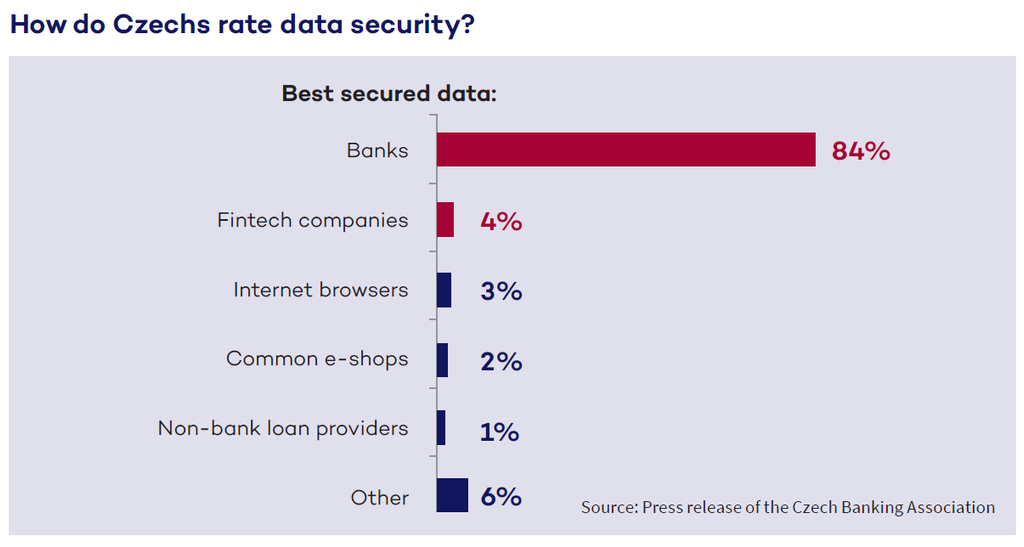
Authors: Robert Nešpůrek, František Korbel, Dalibor Kovář
All our lives we have been asked from time to time to present our ID card, passport or other proof of identity. Therefore, it is hard for us to imagine that soon this will no longer be required. But it’s time for this to change. A whole new world of remote identification is emerging that will be automatic, free of charge and instantly available to more than one half of all Czech citizens. Let us welcome bank identity, one of the most trustworthy and widely used digital identification methods today.
Bank identity is expected to be deployed in the first half of 2021. Its appropriate and timely use may give you an advantage over your competitors.
We got used to trusting our banks and thanks to the permanent development of electronic services and exponentially growing number of possibilities for their application, we commonly procure our matters online. But we still have not gotten used to the idea that we can completely, reliably, electronically authenticate our identity at any time, remotely, without encountering other persons and without any waiting.
Under the Czech legal regulation of electronic identification there has been a state-run electronic identification means – an electronic ID card – available for more than two years now. From the legal point of view, an electronic identity offers a higher level of guarantee than bank identity, however, on the other hand it is necessary to make some efforts and invest some money – to purchase an electronic ID card reader for instance.
Moreover, the possibilities for using an electronic ID are unfortunately very limited. The state is not the best promoter or trader. This type of identity works only for persons who must verify identity under law (such as obligated entities under the AML legislation) or as a part of the exercise of official tasks (so called competencies). This is another reason why the current electronic identities have been used hesitantly and infrequently in practice so far.
But now a revolution in electronic identity checking will come to fore with bank identity. Thanks to bank identity it will be possible to electronically authenticate the identity of individuals (or select information about them) with the use of secured access codes for internet banking. All that without the need to remember any new passwords or to have a special reader. Clients will continue using only what they are familiar with very well – internet banking log-in via a computer or mobile phone. Nothing else. In addition, the user will not pay anything for such authentication.
In this connection, Czech legal regulations use the term electronic identification means – a simple alternative to physical identity documents for individuals’ digital acts in the online world. Thus, these include acts in the public as well as the private sector. But bank identity will not only be about authenticating and transferring client data with the client’s consent. It will also offer users a simple and comfortable log-in with a single digital identity for dozens of user accounts across the Internet (called single sign-on) or simple subsequent payment authorisation. Therefore, it will not be necessary to remember different log-in methods for e-shops and digital services or to fill in complicated forms. Bank identity may thus bring up to 5.5 million potential users to the public and private sector whose identity will be easily authenticable at a distance.
Bank identity is at the same time an electronic signature method. It has already proven to work well in Nordic countries. In Norway, electronic identification and the related signing with a bank identity is used by nearly 90% of the working age population and even by up to 97% of the working population aged 20 to 54 years. The first Czech banks have already informed us that with the use of bank identity they will enable signing electronic documents in a trustworthy environment. For example, Komerční banka already launched its service MůjPodpis (MySignature) several months ago.
In addition, bank identity will also involve a control aspect – anyone will be able to check where and for what purpose their bank identity was used.
Inspired particularly by Nordic countries, bank identities are a well-tested and functional concept – banks own the basic infrastructure and have their clients, at the same time they are the only institutions on the market to have already authenticated the majority of individuals and transferred their identity via bank identity to the digital world. Apart from that, studies show that consumers prefer banks to government, retail or social platforms as providers of digital identity because they trust them; Czech consumers are no exception.

Thus, the introduction of bank identity in the Czech Republic was inspired by the banking sector already in 2017. However, Czech laws did not permit banks to provide electronic identification back then. The Czech Banking Association, as the representative of Czech and international banks, approached the subject from the legislative point of view. With the help of the ICT Union, attorneys from HAVEL & PARTNERS and ROWAN LEGAL and a group of active PMs from the public administration committee drafted Act no. 49/2020 Sb. Although this piece of legislation constitutes an amendment to the Banking Act, the AML Act and other laws, the most apt name for it is the Act on Bank Identity, unofficially abbreviated as the BankID.
This act will enter into effect on 1 January 2021. It broadens the existing group of activities that banks are authorised to carry out by the provision of electronic identification and authentication, services creating trust and other related services. It will also enable banks (and insurance companies) to access the basic registers and other public administration information systems and to check whether their clients’ data are up to date.
If banks or branches of international banks decide to provide these services, they must enable, free of charge, electronic authentication of their clients’ identity also for the use of online services to state, municipal and regional authorities. In exchange, banks will be able to provide these services to the rest of the public sector and to commercial companies, weather directly or via the new company Bankovní identita a.s., a joint venture of the three largest banks on the Czech market – Česká spořitelna, Československá obchodní banka and Komerční banka. The price for the use of electronic identification, authentication or signing services will not be paid by the end user but by the service provider (retailer), who uses the service to identify their clients. A similar set-up for payment cards has been in place for many years.
Providers of e-commerce and services will be willing to invest in bank identity only if they can see benefits for their businesses. Participating banks, and the fact that identification by means of bank identity will also be sufficient to comply with the mandatory AML identification standard for the use of government and public sector on-line services, make bank identity trustworthy. Therefore, we can see the potential for its use primarilyin the financial sector as a single means for on-line identification and payments. In Norway, bank identity is used in more than ¾ of all transactions in the financial sector. Thanks to the use of bank identity the average time required for processing a mortgage application was reduced from 16 days to several hours.
Bank identity will also become important for e-commerce in relation to a part of post-paid services such as fuel cards, energy or telecommunications. The use of bank identity can thus also be interesting for mobile operators or distribution companies.
Bank identity will also be very useful for eGovernment services – typical examples include access to secured registers, portals or files, electronic elections, communication with tax authorities, on-line incorporation of a new firm and further applications during the gradual digitalisation of government services thanks to the implementation of the Act on the Right to Digital Services (no. 12/2020 Sb.).
Another domain for the application of bank identity is employment – in particular in the digitalisation of payroll and tax procedures and to facilitate the recruitment of new employees at larger companies.
Technological partners (ICT suppliers) capable of suitably connecting the bank’s electronic identification with their own services who will simply include the price for the use of bank identity in the price of the service will assume a key position. Naturally, banks cannot appropriately help their clients integrate the solutions in preparation (as they possess only limited technical knowledge), cannot provide technical support for these solutions and often identify use cases in which bank identity can be used outside the banking sector. Thus, in the distribution model of services relating to bank identity, banks must count on their technological partners – typically in commerce, electronic signatures, document keeping, log-in and identity management.
In the Czech Republic this will be the uniform, and by far most frequent, solution for digital identity authentication, taking the way in which society works to a whole new level. In Norway they say with exaggeration that a bank needs to be visited only once in a lifetime – just to set up a bank identity. All the rest can be done afterwards with its help, whether in the private or public sector.
It is expected that bank identity will be launched in the first half of next year. Its appropriate and timely use will undoubtedly be a competitive advantage. The bank identity may lead to increased efficiencies of processes for all participants – simple, comfortable and gratuitous use of a single means of identification and payment for individuals, a competitive advantage and interesting savings for service providers in comparison with their own identification solutions, the possibility for banks to get closer to their clients and to provide them with more comprehensive services, and a brand new gratuitous channel with millions of verified users for the digital services of the state, municipalities and regions.
Our digitalisation legal team, whose members co-authored the Bank Identity Act and participated in the development of this solution from the very beginning, will be happy to help you assess the details of bank identity and implement banking identity means.